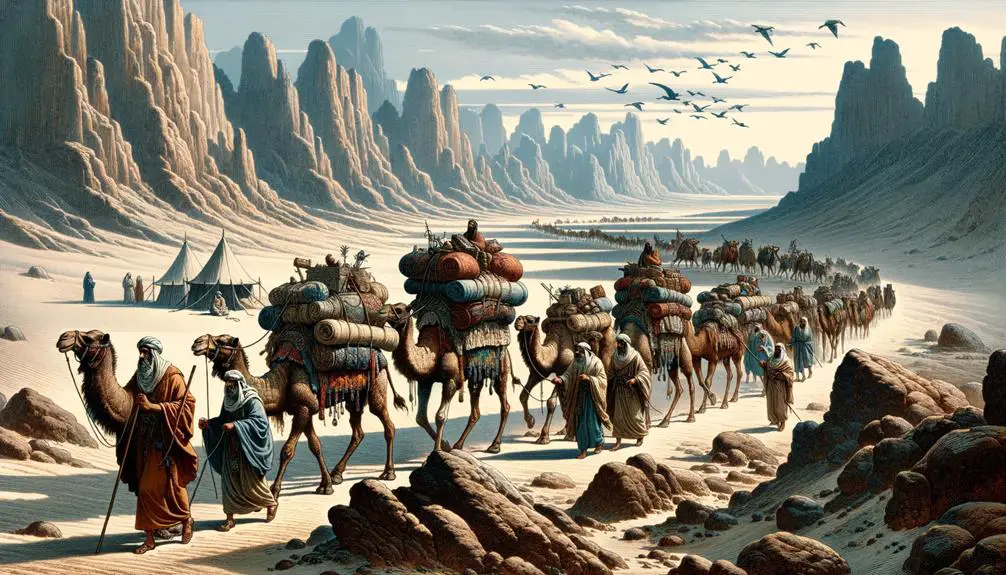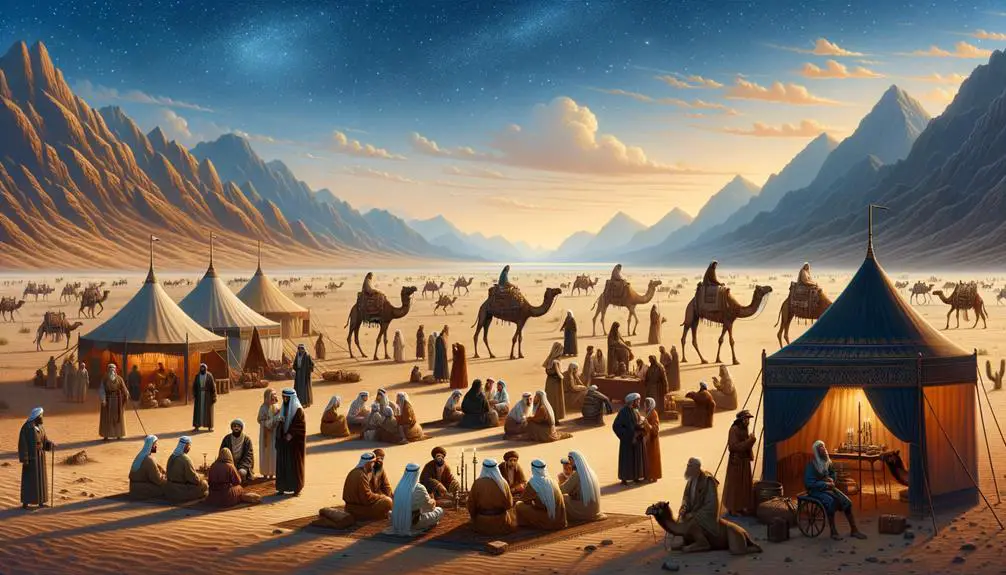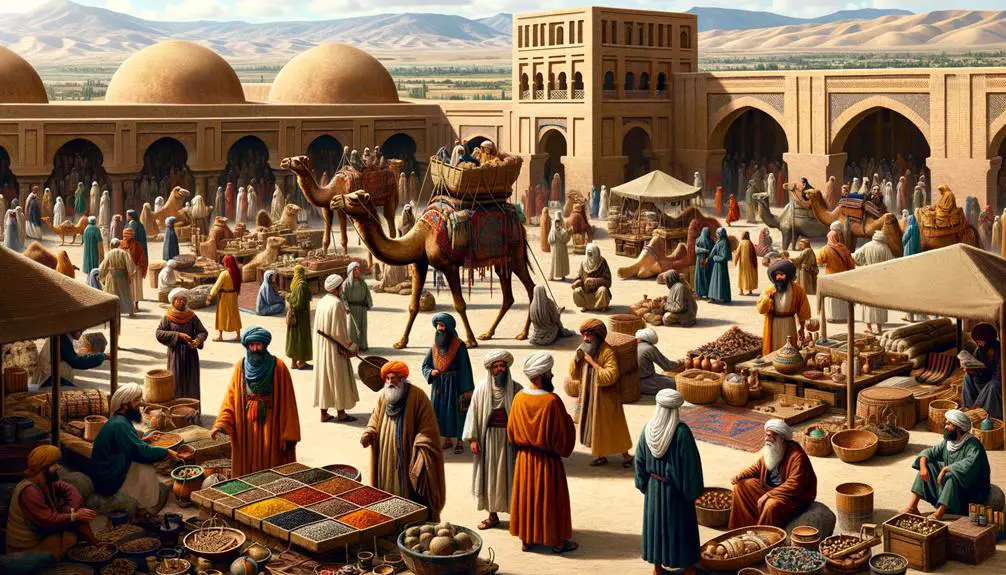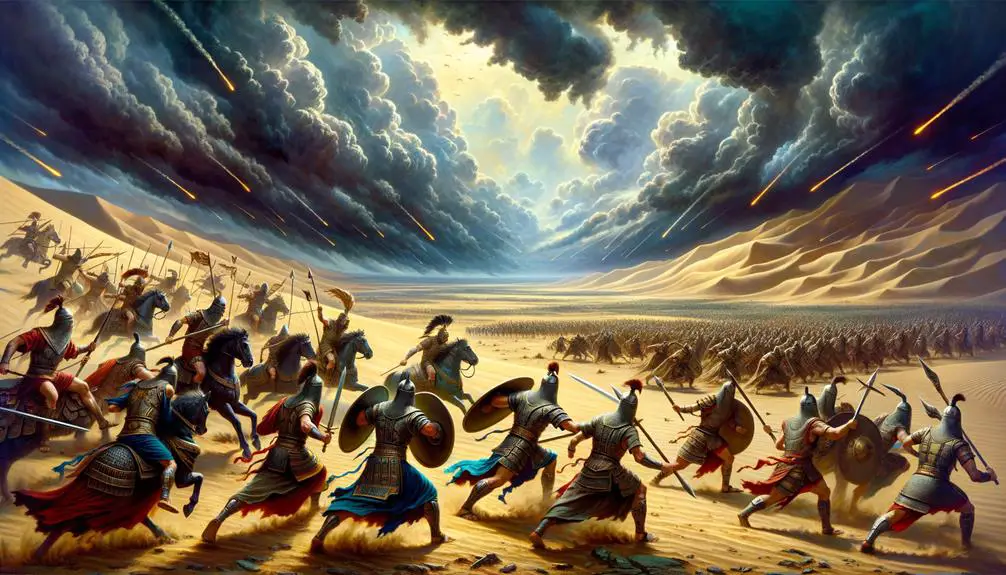Yield to the mystery of the Midianites, a pivotal biblical civilization whose story intertwines with ancient faiths and conflicts, beckoning deeper exploration.

Who Were the Midianites in the Bible
In the grand tapestry of biblical history, the Midianites are a thread woven through with complexity and intrigue. You've likely encountered their story in passing, brushed against the tales of their conflicts with Israel, or perhaps the story of Moses finding refuge among them. Yet, there's so much beneath the surface.
Unraveling who the Midianites were, from their origins to their decline, reveals not just a story of a people but a fascinating glimpse into the cultural and political dynamics of the ancient Near East. You stand on the brink of uncovering how their legacy, archaeological evidence, and key figures shaped, and were shaped by, the biblical narrative.
Why were they such pivotal players, and what can their story teach us about the broader historical and theological contexts they occupied?
Key Takeaways
- The Midianites were descendants of Abraham, settled in the northwest Arabian Peninsula, influencing regional trade and theology.
- They had notable biblical interactions, including conflicts with Israel and Moses' Midianite family connections.
- Their strategic control over trade routes facilitated cultural exchanges and alliances in the ancient Near East.
- Archaeological findings and biblical accounts reveal their significant economic, social, and religious impact before their decline.
Origins of the Midianites

The Midianites, according to biblical accounts, trace their lineage back to Midian, a son of Abraham and his concubine Keturah, showcasing a complex yet pivotal connection within the tapestry of ancient Near Eastern history. This ancestral lineage not only situates the Midianites in a web of familial relations pivotal to biblical narratives but also underscores their significant role in the sociopolitical landscape of the time. Their descent from Abraham places them within a broader narrative of migration, settlement, and interaction among the peoples of the ancient Near East.
You'll find that the geographical location of the Midianites is equally significant, encompassing the northwest Arabian Peninsula, along the eastern shore of the Gulf of Aqaba on the Red Sea. This region, characterized by its arid desert landscapes and occasional oases, played a crucial role in the development of the Midianite society. It positioned them strategically along important trade routes that connected Africa and the Levant, thereby influencing their economic and social structures. Their proximity to Egypt and Canaan placed them at a crossroads of cultural and political exchanges.
Their ancestral lineage and geographical location thus provided the Midianites with unique opportunities and challenges. As descendants of Abraham, they were part of a larger narrative that shaped the religious and cultural milieu of the region. Meanwhile, their strategic location facilitated their involvement in trade networks, contributing to their economic prosperity and cultural exchange. This background sets the stage for understanding the complex interactions between the Midianites and their neighbors, including the Israelites, which are documented in biblical texts.
Biblical Encounters
Throughout the biblical narrative, Midianites frequently emerge as pivotal figures in stories that highlight complex dynamics of conflict, alliance, and cultural exchange with the Israelites. Their presence and interactions provide a fascinating glimpse into the ancient Near East's socio-political and religious landscapes. Here are three significant biblical encounters that underscore the multifaceted relationship between the Midianites and Israelites:
- Conflict and Cooperation: The Midianites are perhaps most famously known for their role in the story of Gideon (Judges 6-8), where they're portrayed as oppressors of Israel, leading to a divine intervention. This narrative emphasizes the cyclical nature of conflict and peace between the two groups, influenced by broader regional power dynamics and the strategic importance of trade routes.
- Cultural and Religious Exchange: The marriage of Moses to Zipporah, a Midianite woman, and his subsequent encounter with her father, Jethro, a Midianite priest (Exodus 2:15-21; 18:1-27), highlight the complexities of cultural and religious interactions. Jethro's advice to Moses on leadership and governance is a key moment of cross-cultural exchange, illustrating the potential for mutual respect and learning.
- Economic Interactions: The involvement of the Midianites in trade routes that connected Egypt with the Arabian Peninsula facilitated not only the exchange of goods but also ideas, including religious practices. This economic interdependency likely contributed to the nuanced nature of Midianite-Israelite relations, characterized by periods of tension and cooperation.
Understanding these encounters sheds light on the significant role the Midianites played in the biblical world, illustrating the interconnectedness of ancient societies through conflict, alliance, and trade.
Cultural Significance

Having explored the pivotal biblical encounters between the Midianites and Israelites, it's crucial to understand the cultural significance these interactions had on shaping the ancient Near Eastern landscape. The Midianites, often depicted as both foes and allies of Israel, contributed significantly to the cultural and religious fabric of the region.
You'll find that their influence extended beyond mere conflict. The Midianites' religious practices, particularly their worship of a plethora of deities, introduced a complex layer of polytheism that clashed with, yet paradoxically enriched, the monotheistic tenets of emerging Israelite religion. This interplay of beliefs likely fostered a cultural dialogue, promoting religious and philosophical exchanges that were pivotal in the evolution of regional theologies.
Moreover, the Midianites' strategic position along key trade routes made them indispensable to the commerce and exchange of goods, ideas, and technologies across the Near East. Their role as intermediaries facilitated not only the movement of commodities like spices, metals, and textiles but also the dissemination of cultural norms and practices. This exchange undoubtedly left an imprint on the social and economic paradigms of the time, influencing everything from dietary habits to artistic expressions.
In analyzing their impact, it's evident that the Midianites were more than mere antagonists in biblical narratives. They were key players in the cultural and religious development of the Near East, acting as catalysts for change and innovation. Their interactions with the Israelites, fraught with conflict and cooperation, underscored a complex relationship that was instrumental in shaping the identity and beliefs of the region's inhabitants.
Political Alliances
In the complex tapestry of Near Eastern politics, Midianite alliances with other entities played a pivotal role in shaping regional power dynamics. By forging strategic relationships, the Midianites not only secured their position within the ancient world but also leveraged these alliances to influence trade routes and diplomatic engagements.
- Control of Trade Routes: The Midianites' geographical location was strategic for controlling vital trade routes that connected Africa and the Near East. By allying with neighboring tribes and nations, they ensured safe passage for goods, which in turn bolstered their economic strength and political leverage.
- Diplomatic Marriages: Marriage alliances were another tool in their political arsenal. By arranging marriages with other influential tribes or nations, they cemented alliances that could be called upon in times of need. These diplomatic marriages served not only as a means of political maneuvering but also facilitated cultural exchanges and strengthened ties between different groups.
- Mutual Defense Pacts: In an era where warfare could drastically alter the balance of power, the Midianites engaged in mutual defense pacts with their allies. These agreements ensured that in the event of an external threat, they could count on the military support of their allies, providing a layer of security and stability within the region.
Through these strategies, the Midianites adeptly navigated the complex political landscape of their time. Their ability to form and maintain alliances through trade control, diplomatic marriages, and defense pacts showcases their sophisticated understanding of power dynamics in the ancient Near East.
Conflicts With Israel

While the Midianites adeptly managed alliances to bolster their regional influence, their interactions with Israel often resulted in conflict, marking a significant chapter in their history. These confrontations were not merely random skirmishes but were rooted in deeper socio-political and religious differences, illustrating the complex interplay between neighboring civilizations in the ancient Near East.
The conflicts between the Midianites and Israel are noteworthy for their demonstration of evolving battle strategies and the occasional attempts at peace treaties. These engagements highlight the strategic considerations of the time, including the use of terrain, the role of leadership, and the importance of intelligence and counterintelligence in warfare.
Here's a concise overview of some key aspects of their conflicts:
Aspect |
Description |
|---|---|
Battle Strategies |
Both sides employed innovative tactics, with the Midianites often utilizing their knowledge of the desert terrain to their advantage. |
Peace Treaties |
Though conflicts were frequent, there were periods where peace treaties were negotiated, showing a willingness to coexist under certain terms. |
Economic Impact |
Raids and conflicts disrupted trade routes and agricultural production, leading to economic instability in the region. |
Cultural Exchange |
Despite hostilities, these interactions led to some degree of cultural exchange, influencing religious practices and social norms. |
Analyzing these conflicts sheds light on the Midianites' resilience and adaptability in the face of adversity, as well as their contributions to the tapestry of ancient Near Eastern history. Understanding their story helps us appreciate the complexity of ancient relationships and the ever-present quest for power, peace, and prosperity.
Key Figures
You'll find that key figures among the Midianites play crucial roles in their interactions with Israel, highlighted by both prominent leaders and pivotal encounters.
These characters not only shape the narrative but also provide insight into the broader socio-political dynamics of the time.
Analyzing these figures allows for a deeper understanding of the complexities within these biblical stories.
Prominent Midianite Leaders
Several Midianite leaders stand out in biblical narratives, each playing pivotal roles in the complex relationship between their people and the Israelites. These leaders were instrumental not only in Midianite trade but also in their religious practices, which often intersected with their interactions with Israel.
- Zipporah: As the wife of Moses, Zipporah's leadership wasn't direct but pivotal in the biblical story, mediating between Moses and her Midianite priest father, Jethro.
- Jethro: Zipporah's father, a priest of Midian, offered Moses sanctuary and wise counsel, illustrating the intricate relationship between faith, leadership, and diplomacy.
- King Eglon: Though not directly mentioned as a Midianite, alliances with Midianites against Israel suggest a shared leadership in opposition, showcasing the Midianites' influence and strategic importance.
Biblical Midianite Encounters
In exploring biblical narratives, it's essential to examine key figures in Midianite encounters, which profoundly influenced the course of Israelite history.
The interactions between the Israelites and the Midianites, often centered around Midianite religion and trade routes, showcase a complex relationship.
These passages highlight how Midianite beliefs and their control over crucial trade paths played significant roles in shaping the political and religious landscape of the region.
Through these encounters, you gain insight into the broader dynamics of ancient Near Eastern societies, where commerce and faith were deeply intertwined.
Understanding these key figures and their interactions offers a nuanced view of the historical and theological context, revealing the intricate web of relationships that defined the ancient world.
Archaeological Evidence

Archaeological findings provide crucial insights into the existence and lifestyle of the Midianites, as described in biblical texts. The evidence not only confirms their presence in history but also sheds light on their cultural and economic practices.
One of the key areas where archaeology has been particularly revealing is in the analysis of trade routes and pottery. Here's how:
- Trade Routes: Excavations have unearthed evidence of well-established trade routes that the Midianites likely used. These routes connected them with neighboring civilizations, facilitating not just the exchange of goods but also cultural and technological ideas. It's fascinating to see how interconnected these ancient societies were, much like today's globalized world.
- Pottery Analysis: Pottery remains, with distinctive designs and craftsmanship, have been critical in understanding the Midianites' daily life and trade practices. The analysis of pottery styles and materials has helped archaeologists pinpoint the origins of these items, revealing a network of trade that extended beyond the immediate region.
- Settlement Patterns: Through the excavation of settlement sites, researchers have been able to map out where the Midianites lived, how they structured their communities, and even how they adapted to their environment over time. This spatial analysis provides a direct window into their world, offering clues about their social organization and economic activities.
This archaeological evidence allows you to grasp the complexity of the Midianites' society, going beyond the biblical narrative to understand their role in the ancient Near East's intricate social and economic tapestry.
Decline and Legacy
As the Midianite civilization began to wane, its once-flourishing legacy faced an inevitable decline, reshaping the historical and cultural landscape of the region. The decline was multifaceted, stemming from the disruption of trade routes and alterations in religious practices, among other factors. You'll find that the shifting dynamics of trade routes, pivotal for the Midianite economy and their interactions with neighboring civilizations, played a crucial role.
As empires rose and fell, the once-dominant trade paths that the Midianites controlled or heavily utilized were either usurped by emerging powers or became less traveled due to the evolution of trade and commerce. This economic downturn significantly weakened their societal structure and influence.
Simultaneously, you'd observe changes in religious practices that further isolated the Midianites from their neighbors and predecessors. The assimilation of Midianite religious elements into the emerging monotheistic religions of the region not only diluted their unique cultural identity but also marginalized their societal standing. This religious transformation contributed to their fading prominence in historical narratives and archaeological records.
Despite their decline, the legacy of the Midianites endures, primarily through biblical accounts and archaeological discoveries that offer insights into their culture, trade practices, and religious beliefs. Their story serves as a testament to the complex interplay of economic, social, and spiritual factors that influence the rise and fall of civilizations. As you delve deeper into the history of the Midianites, you're reminded of the transient nature of power and the enduring impact of cultural and economic exchanges across civilizations.
Frequently Asked Questions
How Do Modern Interpretations and Religious Traditions Outside of Judaism and Christianity View the Midianites?
In modern interpretations and religious traditions outside Judaism and Christianity, the Midianites are often seen through the lens of Midianite mythology and archaeological controversies.
You might find that these perspectives offer alternative views, focusing less on biblical narratives and more on historical and cultural insights.
This analytical approach sheds light on their societal structures, religious practices, and interactions with neighboring cultures, providing a broader understanding of their role in ancient history.
Are There Any References to the Midianites in Non-Biblical Ancient Texts or Inscriptions From Neighboring Cultures?
You might wonder, do ancient texts or inscriptions, beyond the Bible, mention the Midianites? The answer's intriguing.
Yes, archaeological evidence and references in non-biblical texts illuminate their existence. These sources, often found along old trade routes, offer a glimpse into their interactions with neighboring cultures.
They not only confirm the Midianites' historical presence but also enrich our understanding of their societal and economic roles in antiquity, providing an objective, analytical perspective on their legacy.
Have Genetic Studies or DNA Analysis Provided Any Insights Into the Ethnic Background of the Midianites?
You're diving into whether genetic studies or DNA analysis have shed light on the Midianites' ethnic background. While such research could potentially reveal genetic markers indicating their ancestral origins, as of now, there's limited concrete evidence available.
The analysis of ancient DNA is complex and requires well-preserved samples, which are rare. Therefore, pinpointing the Midianites' exact genetic makeup through current studies remains a challenge but is an area ripe for future discoveries.
How Have Artistic and Literary Depictions of the Midianites Evolved From Ancient Times to the Modern Era?
You've noticed that artistic and literary depictions of the Midianites have shifted dramatically over time. Initially portrayed through ancient texts and artifacts, their representation has evolved, influenced by changing cultural interpretations.
Modern adaptations in literature, film, and art often reimagine the Midianites, reflecting contemporary values and insights. This evolution underscores how historical figures are continuously reinterpreted, highlighting the dynamic relationship between past narratives and present-day understandings.
What Role Do the Midianites Play in Contemporary Religious Discourse or Theological Debates Within Judaism, Christianity, or Islam?
You're diving into how Midianite identity and their theological impact play out in contemporary religious debates. These discussions often explore how historical interpretations shape modern views within Judaism, Christianity, and Islam.
You'll find that the Midianites' actions and relationships in sacred texts fuel lively debates about morality, faith, and cultural identity, offering a unique lens through which to examine today's theological challenges.
It's a rich area for analysis, blending ancient narratives with current religious discourse.
Conclusion
In your journey through biblical history, the Midianites stand as a complex tapestry, woven from threads of conflict, alliance, and cultural interchange with Israel. Their story, illuminated by key figures and archaeological finds, showcases their significant yet fluctuating influence.
Like a river that both nourishes and erodes the land it traverses, the Midianites carved a lasting legacy in the historical landscape, their decline marking the end of an era yet preserving their mark on the collective memory.



Sign up